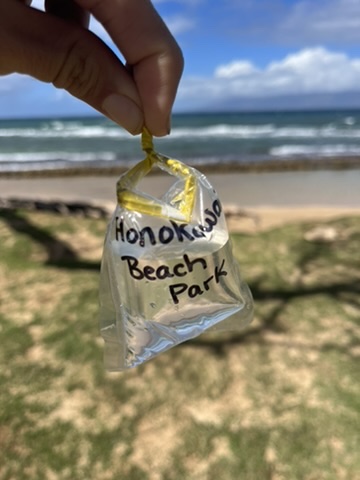
Maui Post-Fires Coastal Water Quality Monitoring Program
Is the Ocean Safe on West Maui?
In 2024 Surfrider Foundation Maui Chapter’s aimed to address this question by collecting water samples near Lahaina and along the west coast of the island to get more information to the public regarding the safety of the water for recreational use. Based on feasibility of testing, toxicity to humans, initial data we tested for metals in Lahaina burn zone and surrounding nearshore coastal waters including Olowalu (directly makai of the Temporary Debris Facility).
Maui Post-Fires Coastal Water Quality Monitoring Program Resources:
June 2024 Post-Fire Water Quality Results
On June 5th 2024, Surfrider Foundation Maui chapter collected a second round of water samples on West Maui to test for fire related metals in coastal waters in and around Lahaina. In line with our previous results from January, we did not find any evidence of fire-related contamination that would put human health at risk from recreation in the ocean. Read more >

Initial Post-Fire Water Quality Results
On January 10, 2024, the Surfrider Foundation Maui Chapter collected samples at eight coastal sites along the Lahaina coastline. We did not find evidence during our initial sampling run of fire-related contamination that would put human health at risk from recreation in the ocean. Read more >
.jpeg?width=1500&height=2000&name=IMG_0157%20(2).jpeg)

Fire Impacts to Ocean Users
The Maui Chapter has been particularly focused on understanding how post-fire toxins may impact ocean goers. Read recent blog posts related to the Lāhainā fire below.
Toxic ash & debris remain present along the Lāhainā shoreline. We strongly advise individuals to avoid the nearby ocean areas.
Blue Water Task Force Data
As part of its Blue Water Task Force Program, the Surfrider Foundation Maui Chapter is analyzing water quality samples along West and South Maui for enterococcus, a fecal indicator bacteria that can indicate the presence of human wastewater or contamination from warm-blooded mammals like pigs and goats. Results after a heavy rain event on January 9 show areas along both West and South Maui exceeding state health standards.

Post-Fire Water Quality Resources
West Maui Water Quality
- Initial post-fire water quality results (4/9/24)
- Post-fire monitoring program (1/27/24 blog post)
- Surfrider Maui Blue Water Task Force Data
- Hui O Ka Wai Ola West Maui testing
- MNMRC 'Know Your Speaker series' Andrea Kealoha presentation on University of Hawai`i coastal water quality monitoring program
Upcountry Maui Post-Fire Resources
